Methods for tying shoelaces. Original ways of lacing boots. Types and methods of lacing.
Experts say: “Shoes, correctly selected for an outfit, are 50% of the success of an image.” A spectacular pair can transform ordinary everyday clothes into an evening dress. But tasteless shoes, on the contrary, will devalue even very expensive and stylish designer dress. Original lacing of shoes will help enhance the effect of a well-chosen pair and make you stand out in the crowd.
A resident of the Australian continent named Jan Figen is considered a true master in lacing. The lacing guru has his own website, where he daily posts more and more new ways to transform factory lacing into original shoe weaving. This is someone you really should learn from to learn how to tie shoelaces and create intricate knots. It turns out that this is a whole art!
5 simple and original lacing methods
In fact, there are a great many methods for lacing shoes. Some of the invented methods to an ordinary person seem convoluted and difficult to implement. But there are 5 ways to tie your shoelaces that everyone can do. They are simple, fast and very original. With their help, anyone can revive the traditional look of their sneakers or sneakers. Below, each of these methods is described step by step.
Lattice
Peculiarities. With just a few manipulations, you can decorate your shoes with a lace-up lattice. This, by the way, is one of the most popular answers to the question of how to tie long shoelaces. To create the lattice you will need long pieces of thin rope. It’s impossible to create such beauty from short pieces. One of the features of this method is that after weaving is finished, it will not be possible to tighten the lacing. To create it, shoes with six or more pairs of holes are suitable.
Execution algorithm
- Cross the laces at right angles, essentially weaving one into the other.
- First, weave the lattice using one cord.
- Then complete the braiding with another lace.
Surprisingly, until the beginning of the twentieth century, lacing was not at all popular. Instead, the shoes were secured to the foot using special buttons and metal buckles, which sometimes had a very bizarre appearance.
Hidden node
Peculiarities. Hidden node - The best way lace up your shoes so that the laces are not visible. This method is especially popular among runners and cyclists. And also among those who are annoyed by the bow that always dangles from the top. The hidden node reveals to passers-by (and to yours too) only the external design, without showing what is going on inside. When using this method for lacing sneakers, you should remember that the method is only relevant for shoes with an even number of holes. Lacing a pair with 3 holes or 5 holes with a hidden knot will not work.
Execution algorithm
- We thread the rope into the bottom hole on one side, passing the lace inside.
- Next we thread its other end into the hole above - in the same row.
- After these two steps, the cord should form a straight line that will be parallel to the line of holes.
- We skip one horizontal row of holes.
- With one end of the rope we go out into the hole above without changing sides.
- All subsequent empty holes in this row are filled in exactly the same way.
- The second vertical row of holes is filled in a similar way.
The second name of the method is closed or straight lacing. He is hallmark Oxford shoes - the “antagonists” of the derby. In the first, unlike the second, the vamp is sewn on top of the ankle boots, and not under them.
Ladder
Peculiarities. The ideal shoes for weaving “stairs” are high boots. And if you also have multi-colored ropes in your shoe arsenal, you can get a bright and unusual lacing masterpiece. It is important that these ropes are not short.
Execution algorithm
- Using the bottom row of holes, thread the ropes from inside the shoes.
- We insert their ends into the second row of holes.
- We cross the ends: the end of the left rope should go under the right and go into the right hole in the third row, and the end of the right should do exactly the opposite.
- Following the algorithm, we continue to lace up the shoes to the very top.
- Having reached top row holes and having laced them, the ends of the ropes need to be pulled apart in opposite directions.
Display
Peculiarities. Each of us has been familiar with this lacing method since childhood. It can be safely called traditional and familiar to our hands and eyes. However, this does not make the Display method any worse or more boring. On some shoes it looks the most neat and advantageous. Important: the “display” is suitable for lacing shoes with an even number of holes - with 4 holes, with six, eight, and so on.
Execution algorithm
- We thread the cord into the bottom hole on the left.
- Skipping one row of holes, we make a kind of zigzag and thread the rope into the second hole from the bottom on the opposite vertical line of the holes.
- We continue in the same spirit to the very top on one side and the other.
Display - most suitable way lacing boots in a classic style.
Lightning
Peculiarities. This lacing method can easily be considered the most feminine and artistic. You should not lace men's shoes using the "Zipper" method. But on high boots or over the knee boots belonging to a representative of the fair sex, “Lightning” will look great.
Execution algorithm
- We start the process from the bottom row of holes.
- We thread both ends of the lace into the lower holes on the inside.
- We wrap each end in its own stitch.
- We reach each end through opposite holes located in the second row.
- We hook each lace under its stitch again.
- We move in this way to the next horizontal row of holes.
You can also lace up figure skates with a zipper. It is not only beautiful, but also functional: the “zipper” efficiently secures sports equipment on the leg.
Selecting weaving for shoes
Of course, any of the lacing options described above can be used for any pair of shoes. But a true shoe perfectionist must know the rules of compliance and skillfully select a method depending on the type of shoe. The following table will help you figure it out.
T table - Correspondence of lacing methods to shoe types
| Lacing method | Sneakers, sneakers | Derby (Open Lace Shoes) | Oxfords (closed lace shoes) | Sports boots | Women's boots, over the knee boots, high-top shoes | Brogues (shoes with perforations) | Anklets, military boots |
|---|---|---|---|---|---|---|---|
| Lattice | + | - | - | - | - | - | - |
| Hidden node | + | + | + | + | - | + | - |
| Ladder | + | - | - | - | - | - | + |
| Display | + | + | - | + | + | + | + |
| Lightning | + | - | - | - | + | + | - |
How to tie your shoelaces beautifully: knots
If development artistic ways lacing is a whole art, then their banal tying is a skill familiar to us from early childhood. And the situation with untied shoelaces is the talk of the town. And not only for kids, but also for adults. It seemed to be tied tightly, checked, tugged. But he took only a couple of steps - and now both ends were already dangling in free flight. You might be surprised, but there are many different ways to tie shoelaces. There are a great variety of them, as well as methods for lacing sneakers and sneakers. Below are just a few of the most popular options.
Classic bow
Peculiarities. A common bow that our parents taught us to tie since childhood is a traditional knot called Ian. In practice, any adult can easily show it. But not everyone can tell it in theory.
Execution algorithm
- Make a loop at the end of the right lace.
- Make a loop at the end of the left lace.
- At the same time we pass both loops made into each other.
- Tighten the loops to form a knot.
The most popular and most frequently found knot on shoes, the Ian knot, received its name thanks to its inventor. The man who figured out how to tie a bow on shoelaces correctly and quickly was named Ian.
Ian's Secure Knot: personalized
Peculiarity. The Ian’s Secure node differs from its “brothers” in its aesthetic appearance. Its highlight is symmetry, and its main advantage is strength.
Execution algorithm
- We form a loop on one rope, and then - exactly the same loop on the other.
- We pass both prepared loops through the middle loop.
- We tighten it.
Translated into Russian, the name of the node sounds like “safe Jan node” - after the name of its inventor.
Double Knot: double
Peculiarities. The name of the node is translated into Russian as “double”. It is rough in appearance, slightly bulky.
Execution algorithm
- We form a regular, standard knot.
- We make the loops a little longer than usual.
- We tie another exactly the same knot.
Two Loop Knot: children's
Peculiarities. It is believed that this particular method of tying boots or sneakers is the easiest for the younger generation to master. The second name for the knot is “bunny ears.”
Execution algorithm
- We make a loop on one rope, and then a similar loop on the other.
- We pass one prepared loop through the middle loop.
- We tie and tighten.
The popular phraseology among young people, “laces in a glass,” means that parents are at home.
Two Stage Knot: Intricate
Peculiarities. This knot can only be called beautiful with a stretch. The reason is the lack of symmetry. However, it can be used to really tie the laces on your sneakers so you don't have to re-tie them after a while.
Execution algorithm
- Form a loop at one end of the rope.
- We encircle the formed loop with the second end of the lace.
- We pass the automatically formed second loop into the middle one.
- We tighten it.
- We encircle the first end with the second end of the lace.
- We thread the first end into the resulting loop.
Stage Knot is a way to prevent shoelaces from coming undone. Even if you pull one lace, the knot will remain tight. Only one part of it will be untied, and not the entire knot.
Surgeon's Knot: surgical
Peculiarities. The knot is simple to perform and very strong.
Execution algorithm
- We form a standard node.
- We thread the left end through the loop again.
- We tighten it.
Surprisingly, the average person will tie a knot in their shoelaces more than 12,000 times over the course of their lifetime.
We lace without tying
If a knot on your shoes interferes with your life, you can use the lacing method without a bow. Elastic laces will do the job perfectly. This is a simple and secure way of lacing sneakers without tying. Simply insert the strips into the holes and adjust to the volume using special fasteners.
Theoretically, a pair of shoes with 12 holes could be laced with two trillion different ways. It’s easy to turn ordinary laces into a bright accent of your look. The main thing is not to be lazy and spend a little time developing dexterity and dexterity in forming knots and patterns. The original lacing of the shoes is seriously captivating, and the result makes passers-by widen their eyes with delight.
Everyone loves sneakers. And not just sneakers. A lot of shoes with laces. Do you want to stand out and be creative? Write down 10 ways to tie your shoelaces in an original way.
Straight lacing.
This option is one of the traditional lacing methods and is suitable for shoes with an even number of pairs of holes. The laces must be tied in straight parallel lines along the entire length of the shoe.
First you need to thread both ends of the lace through the holes and take it inside the shoe. Then insert the right end into the right hole on the second row, bringing it out, and insert it into the opposite left hole on the same row.
After that, the left end of the lace needs to be brought out into the left hole on the third row and thrown to the right hole on the same row. The right end must be inserted into the left hole of the fourth row with the end outward and transferred to the opposite hole.
Using the given technique, lace up the shoes to the last row, tying the ends into a knot.
Cross lacing.
The most common option is when the left and right ends of the lace cross each other along the entire length of the shoe. First you need to pass the lace through the two lower holes and bring it out.
Then cross the ends of the lace and insert them into opposite holes. Tie the laces in this way until the very last holes. The ends of the laces are tied in a knot. This method is considered the simplest and most convenient.
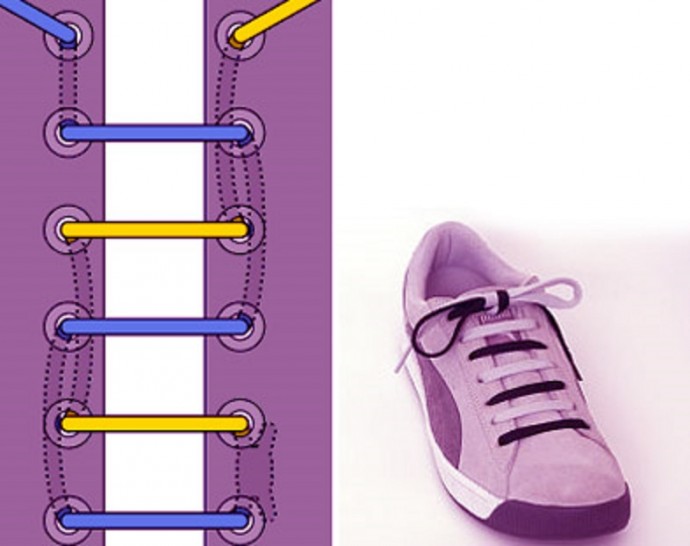
Lacing ladder.
The next method is also called European straight lacing. IN in this case The lace must be threaded into the lower holes with the ends facing inward. Then transfer the left end to the right side and bring it out, skipping one hole.
Then thread it through the hole on the opposite side of the shoe. Thread the right end of the lace into the left hole, bring it out and throw it to the opposite hole.
Then repeat the same steps as with the left end. Thus, straight lines will go from above, and cross lines from below.
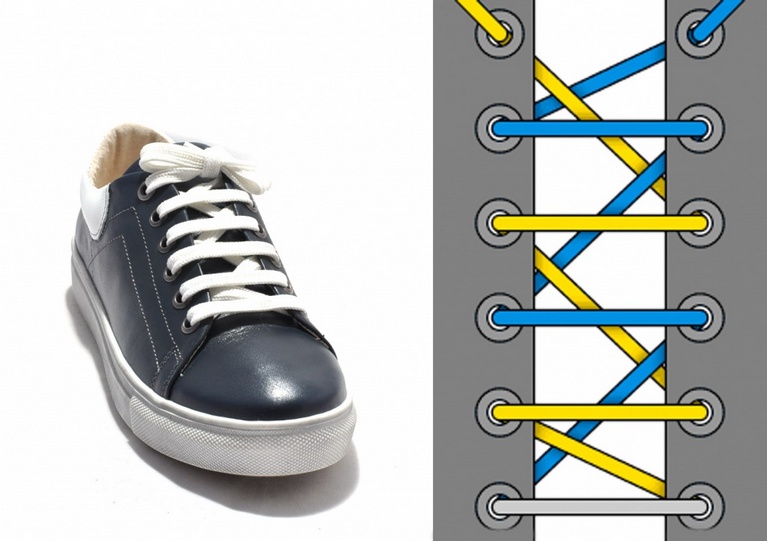
Double reverse lacing.
Only long shoelaces can be tied using this method. You should start lacing from the top holes. Thread both laces into the holes on the second row from the top with the ends inward and pull them down.
Then throw them outward, crossing each other, and also thread the ends inward, passing one row of holes. Having reached the penultimate row, pull the laces inward, cross each other and thread them through the holes.
Then bring the ends out and repeat the steps from the very beginning, now tying the laces from the bottom up. Tie the ends of the lace into a knot.

Knotted segment lacing.
A lacing method with an unusual knot in the middle. This little trick increases the strength of the lacing. On the first row, thread the ends of the lace through the holes and bring them out.
Then cross the laces together and thread them through the holes in the top row. Having thus reached the middle of the boot, form a reef knot. It looks like a double knot: first tie a simple knot, placing the left end of the lace over the right, then make the same knot on top, only placing the right end over the left.
Continue tying your shoelaces cross method until the last row.

Butterfly lacing.
This method got its name because of its similarity in appearance to a bow tie. In this case, the laces go crosswise on the outside of the shoe, and stretch upward in straight lines on the inside.
First you need to pass the lace along the bottom row, threading it through the holes with the ends inward. Then pull both ends vertically up and out into the holes on the second row. This creates a “gap” on the lacing.
Cross the free ends together and thread them through the next pair of holes. In this technique, lace to the end. On the last row, tie the loose ends with a knot.
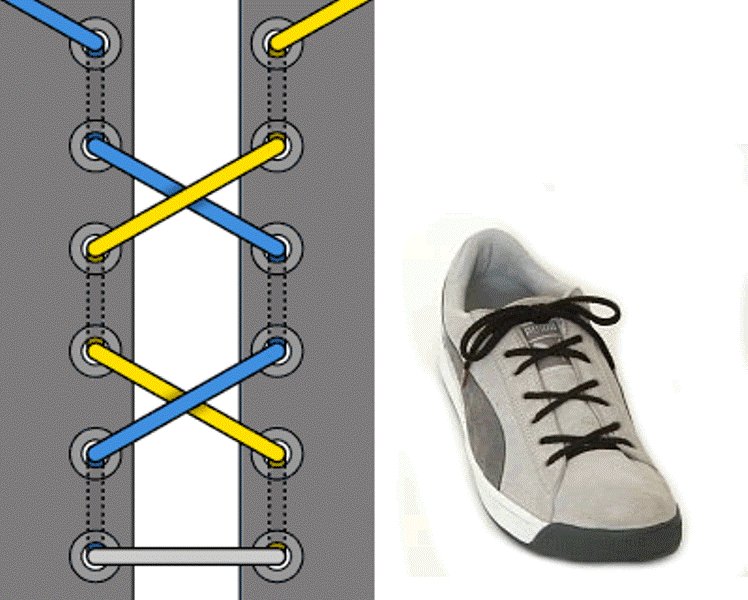
Spiral lacing with a long diagonal.
The lace is threaded through the holes in the bottom row, ends inward. The left end should be significantly longer than the right. Then the left end is thrown up in the opposite direction and brought out through the right hole of the topmost row.
The right end is threaded up into the hole on the left side on the second row. Then it must be inserted into the opposite hole on the right, and again pulled to the left hole on the third row.
In this way, the entire shoe is laced up to the last row. The free ends of the lace are tied with a knot.

Spiral lacing.
This is also a fairly easy way to tie your shoelaces and doesn't take much time. Pass the left end of the lace into the hole of the first row, bringing it out, and the right, on the contrary, letting it in.
Then insert the left end into the right hole on the second row, and the right end, respectively, into the left one. After lacing the last row, thread both laces into the top holes and bring them out, tying them into a knot.

Checkerboard lacing.
Quite interesting and original version lacing using two laces different colors. For this method You will need flat wide laces. Thread a lace of the same color into the holes of the bottom row and tie until the end using the “straight lacing with a hidden knot” method.
Pass a cord of a different color through the resulting horizontal rows using a plain weave method, creating the look of a chessboard. Tie the laces over the entire surface so that both ends are down, after which they must be hidden inside the shoe.
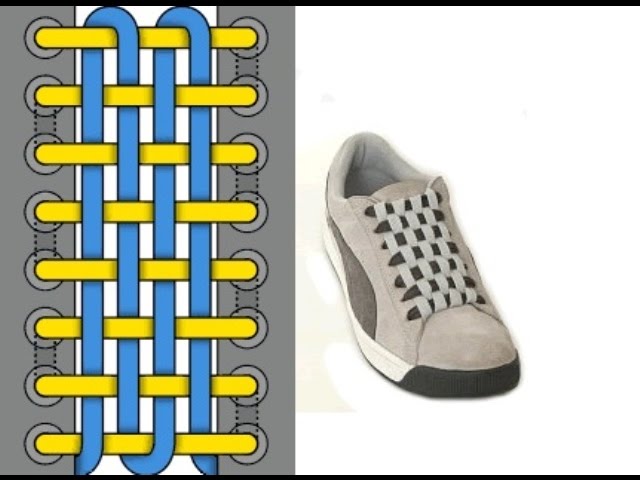
Lattice lacing.
This method is suitable for shoes with at least six pairs of holes. The ends of the lace are threaded through the holes in the bottom row and brought out. Then they need to be crossed among themselves and threaded through the holes, skipping two rows.
Along the inside of the shoe, the laces are lowered down and threaded through the holes of the second row, then pulled up again. In this technique, you need to continue lacing until the last row. The ends of the laces are tied in a knot.

These are the original ways to tie shoelaces? Which one did you like best? Take notes!
Click " Like» and get the best posts on Facebook!
Everyone knows how to tie their shoelaces, but they still try to find new ways to tie their shoes. This is an opportunity to stand out, add stylish casualness and playfulness to your image. Most people know no more than 2 - 3 ways to tie shoelaces. Let's get a look, How you can tie your shoelaces unusual and original.
How to tie your shoelaces beautifully: ways
Double lacing
This method allows you to shorten the laces a little. Insert the rope into the top hole from above, then insert it in a zigzag pattern through three holes to the fourth. When you reach the last hole, insert the lace and continue to pull it out opposite side.
Two-tone lacing
Prepare two different colored laces. Insert one into the hole from below, bring it out in the opposite direction, skip one row of holes. Go to the end and change the color of the lace. Fill empty holes with it.

One-armed method
This method alternates straight and oblique lines. Insert the lace into the bottom hole and go to the parallel one. Drop down to the next hole to the outside.

The Way of the Cross
Cross method. If you look, this lacing consists of large and small crosses. Thread the lace into the bottom hole, bypassing one row of holes, until you reach the end. Fill in the empty rows.
![]()
Fashionable way
Fashionable way. It's very beautiful and unusual way lacing. You will see interesting drawing on your shoes. To do this, insert the lace inside on one side and parallel on the other side. You should succeed straight line. Skip one row and bring the lace through the hole on the same side. Reach the end by filling in the empty rows.
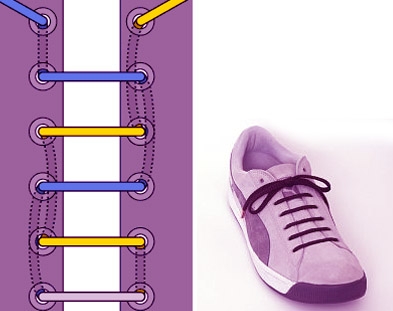
Lace-up with overlay
Slanted lacing. Thread the rope through the hole, making a parallel line. Skip a few holes, make the next parallel. When you reach the end, repeat the same thing. Fill in the empty rows.
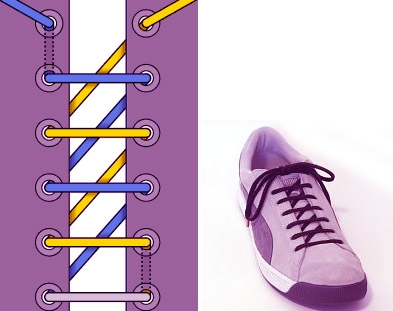
Pigtail
Pigtail. A simple method that even a beginner can handle. Zigzag through the row of holes. Take a lace of a different color and fill in the gaps.

How to tie shoelaces on sneakers in a fun way?
Roman method
Roman method. This method involves the presence of a pattern that looks great on high-top sneakers. Pass the lace through the bottom, pass a row of holes and exit through one on the same side. Reach the end, make a cross. Alternate crosses with stripes.

Butterfly
Butterfly. Quite simple but beautiful lacing. Insert the cord on one side into the hole and bring it out through the next hole on the same side. Go to the opposite side of the row. Pull the string out of the adjacent hole on the same side. Reach the end and repeat the process on the empty rows.
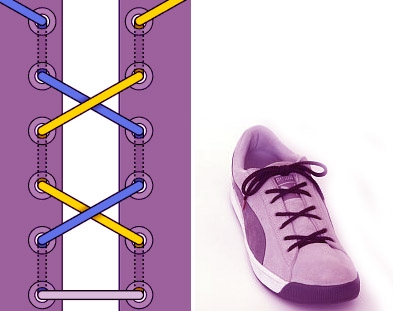
Ladder
Ladder. Make a regular zigzag every other row. Always let the lace out, finish the job and pull the loops of the laces towards the holes.

Double cross
Double cross. Insert the lace into the top hole, extend it up the opposite side into the fourth hole and pull it out through the third. You have a single line. Repeat the procedure in a parallel line through one row. Repeat the process again in reverse.

Double helix
Double helix. Insert the lace into the holes in a zigzag pattern, skipping one row of holes. Go all the way to the end and fill the empty holes with another string.
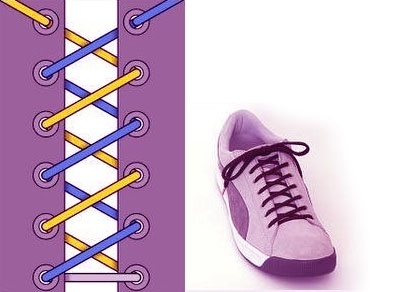
Chess
Chess. This lacing method is performed once. First, insert the laces into the sneakers in parallel lines, without skipping rows. Take a lace of a different color and make a checkerboard, passing it first and then below.

Lightning
Lightning. Pass the lace through the top and make a loop. Skip one row and do the same on the opposite row.
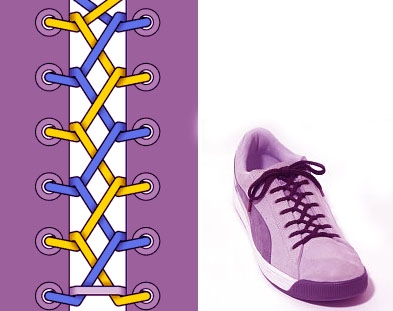
Reverse loop
Reverse loop. Make a figure eight with a lace on one side of the sneaker: insert the rope into the top hole from the bottom. In all other cases, thread the lace from above. Having reached the end along one side, thread the lace and do the same on the second side, threading the rope into the loops of the first row.

Cobweb
Cobweb. Make three parallel lines, when you reach the end, make three lines in the empty rows. Braid the lace between the strips you made.
![]()
How to tie laces on sneakers in a fun way?
Lattice
Lattice. Thread the string through the top hole, insert the string into the fourth hole on the opposite side, and exit through the third hole on the same side. Repeat the process until the end.

Commodity lacing
Commodity lacing. Make a zigzag through one row. Do the same in the empty rows. Alternate the lace inside along the second row: pass from above and below.

Knotted lacing
Knotted lacing. This method starts from the bottom, leading the ropes to the top, weaving them horizontally together. Bring the laces to the top.
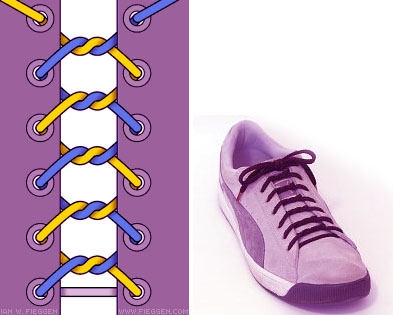
Zonal method
Zonal method. You will need 2 short laces. Lace the first rope from the end, go to the middle and make a bow. Insert the second lace, go to the top and make a bow again.

Shoes or boots, sneakers or moccasins - rare shoes, especially men's ones, do without laces. You can tie them using the classic – quick, simple and standard – method. But it’s much more interesting and cool to use one of the modern fashionable and stylish schemes. There are many options for how to tie your shoelaces beautifully. Below are the most popular of them.
Methods for tying shoelaces
Even such a trivial process as lacing your shoes will turn into an exciting activity. The main thing is to approach it creatively. The options are limited by your imagination and the amount of time you can devote to this process. Cool lacing can be achieved with short and long, narrow and wide ties. You have the power to hide the knot or turn it into main element compositions. Lacing is possible:
- straight;
- double reverse;
- nodal;
- spiral;
- with weaving;
- colored;
- without or with a bow.
Remember: the lace tying pattern determines the ability of the shoe to keep your foot in place. The main condition is your comfort: boots, sneakers or sneakers should not pinch or dangle on your feet. It is worth tightening the knots tighter. They should not come undone when walking! When wearing sports, military (not everyday) shoes, the last factor is an absolute priority.
On sneakers
The question of how to tie laces on sneakers beautifully is relevant for those who cannot imagine life without sports or prefer this type of shoe to all others. It is permissible to use any schemes - both those that are convenient for you when training, and those that will allow you to stand out in the company of your peers. With a little skill, lacing walking, running, basketball, and even warm winter sneakers will be very easy.
The original, unusual lacing of the sneakers is simple straight. Don't pay attention to the boring name and ease of execution - it looks great on shoes. This lacing is suitable for shoes with an even number of holes, for example, with 6 holes on one side. Your actions:
- Insert the tip into one of the upper holes, and out into the lowest hole on the same side.
- Pass the cord through all the holes of the sneaker in such a way that it forms lines parallel to each other.
- Bring the other end through the opposite hole to tie with a knot.
tie short shoelaces? Use the butterfly lacing principle. It is also possible to resort to it if your favorite sneakers have an odd number of holes, for example, with 5 holes on each side. How to proceed:
- Insert the ends of the lace into both of the farthest holes at once so that it is on top of the tongue of the sneaker.
- Alternately lace each end of the tie in a criss-cross manner along the top. Having done everything correctly, you will see that the bow will be at the very end of the tongue.
Want to know how to quickly tie the laces on sneakers with 4 holes on each side? The method proposed below is so simple and convenient that you can actually secure your sneakers with just one hand:
- Tuck a knot at one end of the tie, and bring the other under any of the topmost holes.
- Using a zigzag motion, pass the tie along the top from one hole to another parallel to it. Then go along the bottom of the lacing - to the opposite bottom, until you reach the very last hole.
- Pull the free end of the cord up under the resulting lacing.
How to lace sneakers beautifully
Sneakers are a constant favorite of young people. Comfortable, practical, stylish, versatile, such shoes can be found in the wardrobe of any teenager - or a person who has long left adolescence, but always feels like he is 18 years old. The instructions on how to tie the laces on sneakers beautifully also apply to Converse. These shoes are small in size and discreet. Cool design of the tie with complex knitting is one of the ways to emphasize the individuality of the owner of the sneakers.
In this case, the “Ladder” system is quite applicable. Large long colored ties would be appropriate. You will have to tinker, but the result will please you.
- Pass the laces through the bottom holes and insert the ends into the topmost holes.
- Place the ends of the ties on top of each other crosswise and thread them under the resulting longitudinal lacing.
- Repeat the procedure to the very top, decorate the ends in the form of a bow.
How to tie shoelaces
Reference shoe classic style- shoes. They are worn with strict business attire that does not allow excesses. There is no requirement to wear shoes beyond the dress code. Thin ties of the same color as the shoes themselves are also not conducive to experiments with appearance. Do you like formal closed lacing or an open style? Whatever your preference, the lacing on your shoes should look perfect. A neat rectangular one would be appropriate in this case.
- Pull the lace out of one of the top holes and insert it into the opposite one.
- After passing the tie from the bottom through one hole, pull it out and again pass it from the top to the hole located parallel to it.
- Make lacing in this way along the entire length of the tie.
- When you're done lacing your shoes, you should have a dainty ladder with a bow at the top.
How to lace ankle boots
When fixing ankle boots on your leg, it is not so important how beautifully you tie the laces on them. These shoes are not everyday shoes. On a hike, in field conditions, it is much more important that the tightener is comfortable and that the tying itself occurs quickly. Yes, and if necessary, you need to remove the ankle boots in a matter of seconds. Therefore, experienced hikers recommend using the simplest cross lacing: the tie is pulled from the bottom to the top with large stitches, moving from one side of the tongue to the other.
Video: types of lacing
Much more clearly the original ways of fixing shoes are presented in the videos below. Thanks to them, you will learn how to beautifully tie a bow on your shoelaces, and how to stand out in the crowd by wearing regular sneakers. You will learn how to lace with two ties of different colors at once in a checkerboard pattern, where each checkerboard will be different from the neighboring ones. You have the power to look different without spending a penny on it, just by resorting to various types fixing shoes. Dare to be fashionable!
How to tie shoelaces on sneakers in an original way
How to lace your shoes beautifully
Checkerboard lacing
Almost everyone's wardrobe includes shoes with laces. With a creative approach, you can add a bit of variety and originality to your appearance, applying various ways lacing.
Different lacing for the same pair of shoes can radically change its perception. And some shoe models require certain lacing methods.
Let's consider the main ones:
1. Criss-cross lacing
One of the most common methods for boots and shoes with high tops.
How to do it:
- the laces are passed from below through the two lower holes and brought out;
- the laces cross over each other and are woven into the next holes above from the bottom outwards;
- repeat the steps until the last holes at the boot are reached.
Peculiarities:
— such external lacing does not cause discomfort when worn and does not rub
- Using this lacing method can change the shape of the shoe.
2. External lacing
Cross lace segments are placed alternately over and under the holes.
How to do it:
- through the first holes, the laces are passed to the inside, where they are crossed with the ends leading up in the next holes;
- the laces cross again, but now above the holes, and then wind from top to bottom;
- the procedure is repeated for all holes.
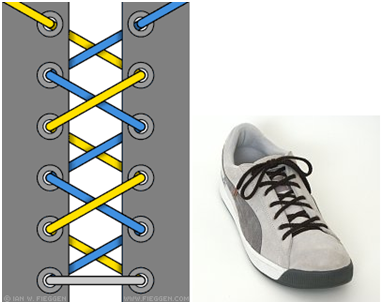
Features of the method:
- the laces on the shoes look like they are separate decorative element;
— with this method, the laces wear out less;
- if there is an odd number of holes on one side, lacing must begin from the inside of the shoe to ensure that the final turn comes out from the inside.
3. Straight European, or ladder lacing.
A European way to tie your sneakers laces beautifully. Parallel lines The incoming laces give the shoes a strict and laconic appearance. This method is most popular in Europe.
How to do it:
- on the right and left, the laces are threaded through the initial holes from the inside out;
- one of the laces ( yellow color) crosswise issued on front side;
- the other end (blue) must also be crossed out into the hole on the opposite side from bottom to top, but skipping one nearest hole;
- the technique is repeated sequentially until lacing is completed.

Peculiarities:
— has a familiar and very neat appearance; the logic of making stitches seems incomprehensible at first, but when mastered, it definitely pleases with the result;
— provides reliable fixation of the foot;
— found wide application on footwear for military personnel;
- can be quickly opened with a knife in extreme situations.
4. Straight fashion lacing
How to do it:
— the lace is launched through the first holes and threaded inward from both sides;
- one of the free ends is drawn with right side from bottom to top, brought out, then inserted into the hole from the left to the inside, passed from the wrong side and brought out through one hole
- similar actions are mirrored for the other end of the lace on the opposite side
- repeat until the weave is completely formed.
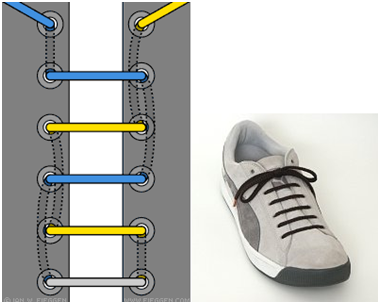
Peculiarities this method:
- very aesthetic weaving
— there are no diagonal unaesthetic constrictions on the inside
- for correct lacing it is required even number holes on both sides
5. Lace with hidden knot
The hidden bow of the laces gives the shoes an original appearance. At the same time, the even rows of the seam itself perfectly complement the overall picture.
How to do it:
- at the very beginning, you need to make sure that one end of the lace is significantly longer than the second
- laces are passed from the wrong side
— the lace knot itself is placed on the right or left side as desired
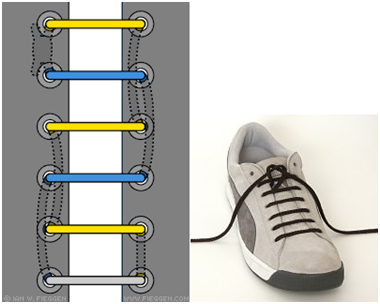
Peculiarities:
- just great looks
— a knot from the inside on some types of shoes can cause inconvenience, but you can always tie it from the outside
- there must be an even number of holes on both sides
7. Straight simplified lacing
This is the easiest way to get a fashionable seam on the laces.
How to do it:
– along one edge the lace is threaded from the bottom hole to the top.
- the second end must be drawn using the direct lacing method sequentially through a series of holes
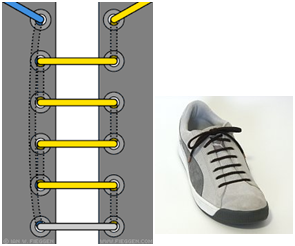
Peculiarities:
- nice appearance
- there must be an even number of holes on both edges
8. Lacing with a cross ladder
The lacing method can be used not only to obtain an original designer look, but also to reduce long laces. In the dress uniform of the US military, this method is used in combination with white laces.

Peculiarities: On high-top boots and sneakers with a large number of holes, this method looks especially impressive. And the use of luminescent laces allows you to get a stunning effect.
9. Double reverse lacing
Boots laced using this method are quite difficult to tighten. But at the same time, it has an impressive appearance and very securely tightens the shoes and fixes the foot. Can be used to shorten laces.
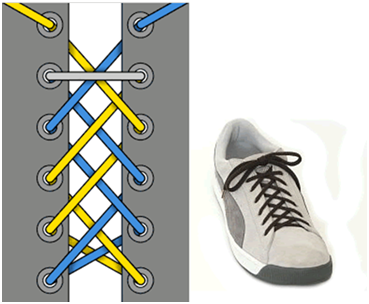
10. Double reverse lacing to reduce the length of the laces
As in the previous method, it is difficult to tighten, which is compensated by original drawing weaving and reliable fixation.
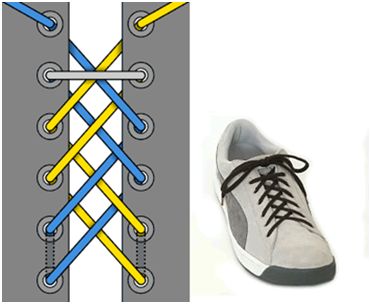
11. Lacing with butterfly
You can tie the laces beautifully on your sneakers with a “butterfly”. This lacing got its name because external resemblance lace knots. It has a very original appearance and can lengthen the laces. To do this, the ends of the laces are run crosswise from the outside and passed flush along the sides of the seam.

12. Double spiral lacing
Provides very fast lacing due to the fact that it is made in a spiral pattern on the outside and inside of the shoe.

Peculiarities:
For an original appearance, it is better to lace the right and left shoes in a mirror manner. This method reduces friction along the length of the lace, allowing for quick tightening and loosening. At the same time, the speed of lacing also increases due to the possibility of tightening both laces at the same time. This method opens up scope for experiments with multi-colored laces.
13. Double cross lacing
It has a very original appearance, which is associated with ancient script.
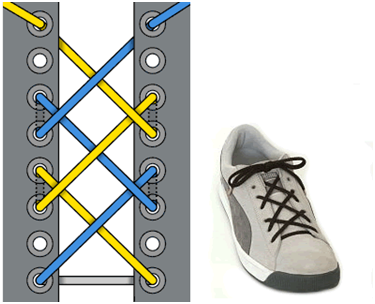
Peculiarities:
More suitable for models with an even number of holes. Otherwise, one row may not be laced. You can do the lacing so that the knot is hidden at the bottom.
14. Lattice lacing or checkered lacing
It has an original picturesque pattern.

Peculiarities:
On shoes with an odd number of holes, it is possible to reach the shaft at different angles. And achieve different arrangements of cross patterns in height.
By making the crosshair one of the very first turns, you can avoid empty rows.
15. Web lacing
This method is harmoniously suitable for shoes with a wide tongue, creating a pattern in an empty space.

Peculiarities:
Shoes with six pairs of holes for laces are simply created for this method. It is possible to make weaves for laces of various lengths. In any case, the result will provide a stunning appearance. To carry out this weaving, it is recommended to use wide laces.
16. Lace-up zipper
An extremely difficult option for tightening, used for lacing sports skates. Appearance resembles a large lightning bolt.

